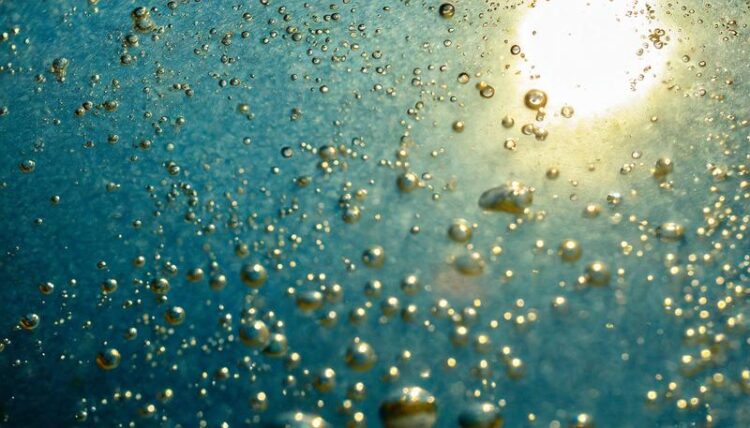Capturing greenhouse gases with the help of light

In the new process, air is channelled through a liquid to capture CO2. If the liquid is irradiated with light, the greenhouse gas is released again and can be collected (AI-generated symbol image).
Credit: ETH Zurich
If we want to slow down global warming, we need to drastically reduce greenhouse gas emissions. Among other things, we need to do without fossil fuels and use more energy-efficient technologies. However, reducing emissions alone won’t do enough to meet the climate targets. We must also capture large quantities of the greenhouse gas CO2 from the atmosphere and either store it permanently underground or use it as a carbon-neutral feed material in industry. Unfortunately, the carbon capture technologies available today require a lot of energy and are correspondingly expensive.
That’s why researchers at ETH Zurich are developing a new method that uses light. With this process, in the future, the energy required for carbon capture will come from the sun.
Light-controlled acid switch
Led by Maria Lukatskaya, Professor of Electrochemical Energy Systems, the scientists are exploiting the fact that in acidic aqueous liquids, CO2 is present as CO2, but in alkaline aqueous liquids, it reacts to form salts of carbonic acid, known as carbonates. This chemical reaction is reversible. A liquid’s acidity determines whether it contains CO2 or a carbonate.
To influence the acidity of their liquid, the researchers added molecules, called photoacids, to it that react to light. If such liquid is then irradiated with light, the molecules make it acidic. In the dark, they return to the original state that makes the liquid more alkaline.
This is how the ETH researchers’ method works in detail: The researchers separate CO2 from the air by passing the air through a liquid containing photoacids in the dark. Since this liquid is alkaline, the CO2 reacts and forms carbonates. As soon as the salts in the liquid have accumulated to a significant degree, the researchers irradiate the liquid with light. This makes it acidic, and the carbonates transform to CO2. The CO2 bubbles out of the liquid, just as it does in a bottle of cola, and can be collected in gas tanks. When there is hardly any CO2 left in the liquid, the researchers switch off the light and the cycle starts all over again, with the liquid ready to capture CO2.
It all depends on the mixture
In practice, however, there was a problem: the photoacids used are unstable in water. “In the course of our earliest experiments, we realised that the molecules would decompose after one day,” says Anna de Vries, a doctoral student in Lukatskaya’s group and lead author of the study.
So Lukatskaya, de Vries and their colleagues analysed the decay of the molecule. They solved the problem by running their reaction not in water but in a mixture of water and an organic solvent. The scientists were able to determine the optimum ratio of the two liquids by laboratory experiments and were able to explain their findings thanks to model calculations carried out by researchers from the Sorbonne University in Paris.
For one thing, this mixture enabled them to keep the photoacid molecules stable in the solution for nearly a month. For another, it ensured that light could be used to switch the solution back and forth as required between being acidic and being alkaline. If the researchers were to use the organic solvent without water, the reaction would be irreversible.
Doing without heating
Other carbon capture processes are cyclical as well. One established method works with filters that collect the CO2 molecules at ambient temperature. To subsequently remove the CO2 from the filters, these have to be heated to around 100 degrees Celsius. However, heating and cooling are energy-intensive: they account for the major share of the energy required by the filter method. “In contrast, our process doesn’t need any heating or cooling, so it requires much less energy,” Lukatskaya says. More than that, the ETH researchers’ new method potentially works with sunlight alone.
“Another interesting aspect of our system is that we can go from alkaline to acidic within seconds and back to alkaline within minutes. That lets us switch between carbon capture and release much more quickly than in a temperature-driven system,” de Vries explains.
With this study, the researchers have shown that photoacids can be used in the laboratory to capture CO2. Their next step on the way to market maturity will be to further increase the stability of the photoacid molecules. They also need to investigate the parameters of the entire process to optimise it further.
Journal: Chemistry of Materials
DOI: 10.1021/acs.chemmater.3c02435
Method of Research: Experimental study
Subject of Research: Not applicable
Article Title: Solvation-Tuned Photoacid as a Stable Light-Driven pH Switch for CO2 Capture and Release
Article Publication Date: 20-Dec-2023
Media Contact
Peter Rueegg
ETH Zurich
peter.rueegg@hk.ethz.ch
Office: 446-324-532
Media Contact
All latest news from the category: Process Engineering
This special field revolves around processes for modifying material properties (milling, cooling), composition (filtration, distillation) and type (oxidation, hydration).
Valuable information is available on a broad range of technologies including material separation, laser processes, measuring techniques and robot engineering in addition to testing methods and coating and materials analysis processes.
Newest articles

First-of-its-kind study uses remote sensing to monitor plastic debris in rivers and lakes
Remote sensing creates a cost-effective solution to monitoring plastic pollution. A first-of-its-kind study from researchers at the University of Minnesota Twin Cities shows how remote sensing can help monitor and…

Laser-based artificial neuron mimics nerve cell functions at lightning speed
With a processing speed a billion times faster than nature, chip-based laser neuron could help advance AI tasks such as pattern recognition and sequence prediction. Researchers have developed a laser-based…

Optimising the processing of plastic waste
Just one look in the yellow bin reveals a colourful jumble of different types of plastic. However, the purer and more uniform plastic waste is, the easier it is to…



